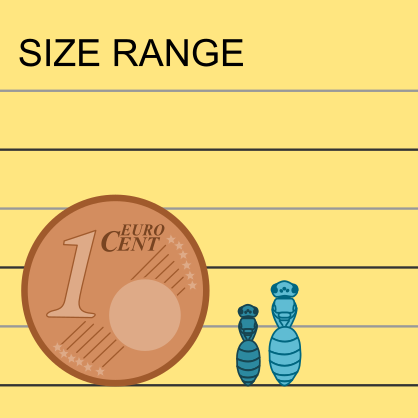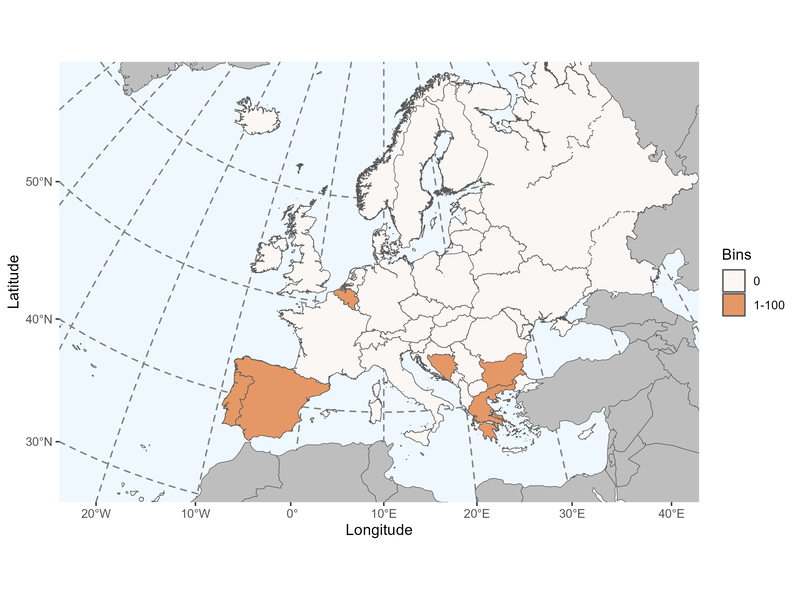Author: Michener, 1948
|
Type species: Hypanthidium halophilum Cockerell, 1936, by original designation.
Subgenera: Mesanthidium Popov, 1950. |
Clade: Anthophila
Family: Megachilidae SubF: Megachilinae Tribe: Anthidiini |
|
Distinctive traits
|
Pictures of distinctive traits.
|
Morphologically close genera and how to distinguish them
Anthidium species have a basal margin of the clypeus and subantennal suture straight.
Icteranthidium & Pseudoanthidium species have axilae pointed or produced, the apex separated from the scutellum.
Anthidiellum, Rhodanthidium & Trachusa species do have an arolium between their claws.
Megachile and Lithurgus species have a second recurrent vein anteriorly connecting within or at the end of the second submarginal cell.
Melitturga species have a truncated marginal cell, a second recurrent vein anteriorly connecting at the second submarginal cell, males with enlarged eyes and females without a ventral brush.
- Afranthidium - Anthidium
Anthidium species have a basal margin of the clypeus and subantennal suture straight.
- Afranthidium - Icteranthidium & Pseudoanthidium
Icteranthidium & Pseudoanthidium species have axilae pointed or produced, the apex separated from the scutellum.
- Afranthidium - Anthidiellum, Eoanthidium, Rhodanthidium & Trachusa
Anthidiellum, Rhodanthidium & Trachusa species do have an arolium between their claws.
- Afranthidium - Megachile, Lithurgus
Megachile and Lithurgus species have a second recurrent vein anteriorly connecting within or at the end of the second submarginal cell.
- Afranthidium - Melitturga
Melitturga species have a truncated marginal cell, a second recurrent vein anteriorly connecting at the second submarginal cell, males with enlarged eyes and females without a ventral brush.
General comments on Afranthidium species identification
Among other criteria, species can be diagnosed by the coloration, mandible teeth, last apical sternites and genitalia in males.
Among other criteria, species can be diagnosed by the coloration, mandible teeth, last apical sternites and genitalia in males.
Sorry, but the species identification tool is not yet available for Afranthidium.
Please check the reference(s) below for traditional keys.
Please check the reference(s) below for traditional keys.
List of the 2 Afranthidium species found in Europe (Ghisbain et al. 2023):
Afranthidium (Capanthidium) schulthessii (Friese, 1897)
Afranthidium (Mesanthidium) carduele (Morawitz, 1876)
Afranthidium (Capanthidium) schulthessii (Friese, 1897)
Afranthidium (Mesanthidium) carduele (Morawitz, 1876)
References with identification keys for some of the species:
- Warncke, K. 1980. Die Bienengattung Anthidium Fabricius, 1804 in der Westpaläarktis und im turkestanischen Becken. Entomofauna 1(10): 119-210.
Page contributors:
You noticed a mistake? You have a suggestion to improve this page?
Don't keep it to yourself, please contact us and become a contributor to IDmyBee!
- Adrien Perrard (Dec. 2023)
- Adrien Perrard (Dec. 2019)
You noticed a mistake? You have a suggestion to improve this page?
Don't keep it to yourself, please contact us and become a contributor to IDmyBee!
References used to write this page:
- Ghisbain, G., Rosa, P., Bogusch, P., Flaminio, S., Le Divelec, R., Dorchin, A., Kasparek, M., Kuhlmann, M., Litman, J., Mignot, M., Müller, A., Praz, C., Radchenko, V.G., Rasmont, P., Risch, S., Roberts, S.P.M., Smit, J., Wood, T.J., Michez, D. & Reverte, S. (2023). The new annotated checklist of the wild bees of Europe (Hymenoptera: Anthophila). Zootaxa, 5327(1), 1-147.
- Michener, C.D. 2007. The Bees of the World, 2nd Edition. The John Hopkins University Press, Baltimore.
- Michez D., Rasmont P., Terzo, M., Vereecken, N. 2019. Abeilles d'Europes. Hymenoptères d'Europes, Volume 1. N.A.P. Editions.
- Nieto, A., Roberts, S. P., Kemp, J., Rasmont, P., Kuhlmann, M., García Criado, M., ... & Michez, D. 2014. European red list of bees. Luxembourg: Publication Office of the European Union, 98.
- Rasmont, P., Devalez, Jelle, Pauly, A., Michez, D. & Radchenko, V.G. 2017. Addition to the checklist of IUCN European wild bees (Hymenoptera: Apoidea). Annales de la Société entomologique de France 53: 17-32.



